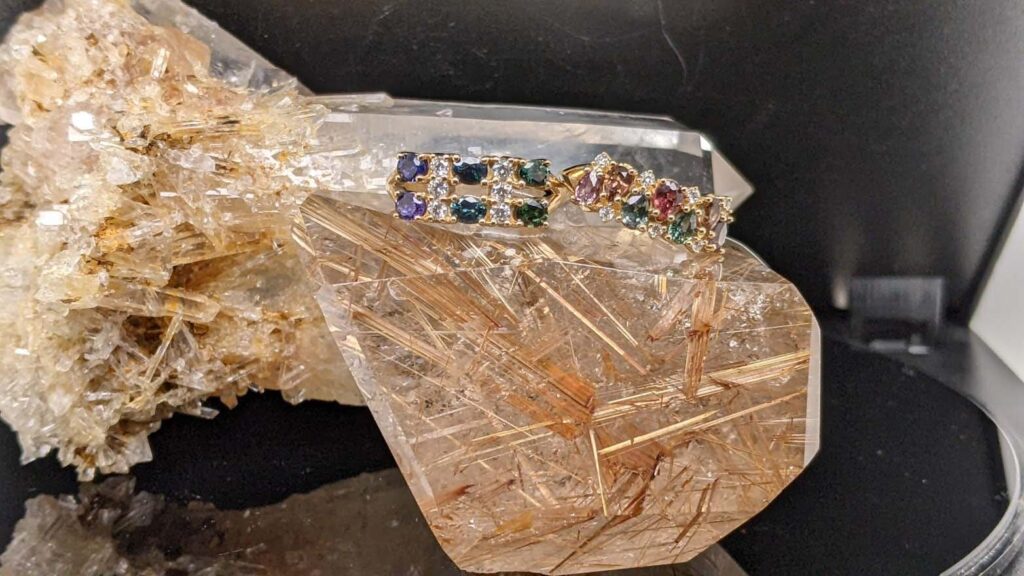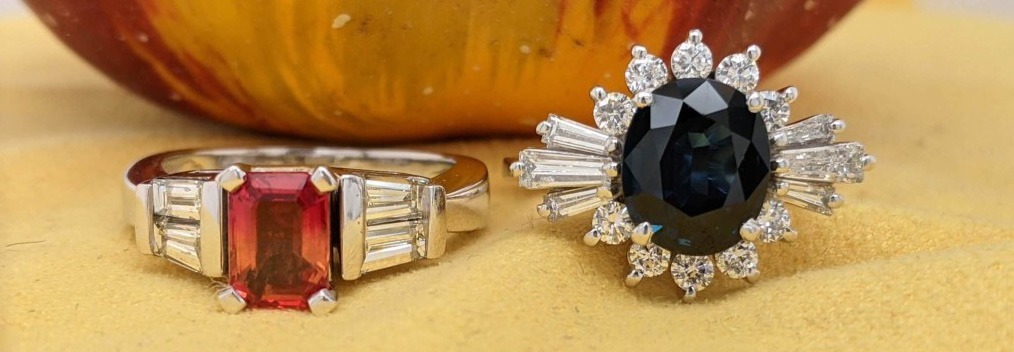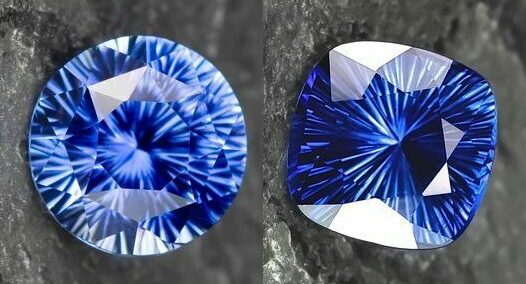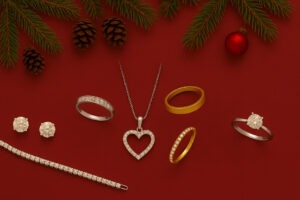For hundreds of years, sapphires have mesmerized humankind with their vibrant blue hues. Sapphires were once considered a sign of wealth, honor, faithfulness, and health. In ancient Greece and Rome, it was believed that sapphires protected their owners from envy and harm. During the Middle Ages, the clergy wore blue sapphires to symbolize the heavens and peace. In today’s society, blue sapphires often evoke thoughts of romance and royalty, thanks to Princess Diana’s iconic engagement ring.
A World of Color: More Than Just Blue Sapphires
When you ask someone to picture a sapphire, they usually imagine a vivid, royal blue stone. However, did you know sapphires come in a wide range of colors and have unique properties? Sapphires can be found in hues from pink to teal to purple. The only color you won’t find in a sapphire is red—a red corundum (the scientific term for sapphire) is actually a ruby. Sapphires are mined worldwide, including in our sister state of Montana. Often, high-quality sapphires of certain colors are sourced from specific regions. For example, Australia is renowned for its blue-green sapphires, while the prized Padparadscha sapphires, known for their pinkish-orange hue, are primarily mined in Sri Lanka. Although similar sapphires are also found in Madagascar and Tanzania, most experts agree that authentic Padparadscha sapphires originate from Sri Lanka.

Unique Properties of Sapphires
Sapphires can have amazing properties, making your stone even more unique and eye-catching. Bi-colored sapphires exhibit two distinct colors within the same stone, a phenomenon known as color zoning. This can appear as a subtle gradient between the two colors or as a sharp line where they meet. Star sapphires are another fascinating variety, displaying a dazzling star pattern when light hits them at the right angle. This effect is caused by fine spindle-like inclusions near the sapphire’s surface. One of the most intriguing types is the color-change sapphire, which appears to change color under different lighting conditions, with the most common shift being from blue to purple.
Historical Anecdotes and Myths
Throughout history, sapphires have been surrounded by myths and legends. In ancient Persia, it was believed that the Earth rested on a giant sapphire, and its reflection colored the sky. In medieval Europe, sapphires were worn by royalty and clergy as protection from harm and envy. The gemstone was also thought to bring wisdom and purity to its wearer. These stories add to the mystique and allure of sapphires, making them beautiful and historically significant.
Why Sapphires Are a Great Addition to Your Jewelry Collection
The vast range of colors and properties are not the only reasons that sapphires make a great addition to your jewelry collection. They are also very durable stones, perfect for everyday wear. Sapphires are the second hardest gem used in jewelry, next to diamonds, with a rating of 9 on the Mohs hardness scale. This means very few materials can scratch the surface. Sapphires are also very stable—common chemicals and extreme heat won’t damage them. Due to their crystal structure, sapphires are difficult to crack, chip, or break. That said, no stone is indestructible, so treating them with care and respect is essential to prevent damage. If you’re looking for a classic, one-of-a-kind gemstone that will stand the test of time, sapphires may be the perfect stone for your next jewelry purchase.
Buying Tips: What to Look for in a Sapphire
When buying a sapphire, there are a few key factors to consider. Color is the most important aspect—look for vibrant stones, even with color saturation. Clarity is also crucial; while some inclusions are common in sapphires, they should not be visible to the naked eye. The cut of the sapphire affects its brilliance and overall appearance, so choose a well-cut stone that reflects light beautifully. Lastly, consider the carat weight, which will affect the size and price of the stone.
Caring for Your Sapphire Jewelry
In addition to home care, it’s recommended that your sapphire jewelry be professionally cleaned and inspected at least once a year. Professional cleaning can remove built-up dirt and oils that are difficult to eliminate with home cleaning, restoring the stone’s brilliance. During the inspection, a jeweler can check for any signs of wear or damage to the setting, ensuring that your jewelry remains secure and beautiful for years to come.
When not wearing your sapphire jewelry, store it in a soft pouch or a lined jewelry box to protect it from scratches and other damage. Keep it separate from other gemstones to avoid accidental scratching, as sapphires can scratch softer stones. Proper storage will help preserve your sapphire’s luster and prevent unnecessary wear.
How Sapphires Compare to Other Gemstones
Compared to other gemstones, sapphires offer a unique combination of beauty, durability, and historical significance. While diamonds are the hardest and most well-known gemstones, sapphires provide a broader range of colors and can be a more affordable option for those looking for a vibrant and distinctive stone. Rubies, also a type of corundum like sapphires, are limited to red hues, making sapphires a more versatile choice for those who want variety.

Ethical Considerations: Sourcing Your Sapphire
When purchasing a sapphire, it’s important to consider its origin. Look for sapphires that are ethically sourced, ensuring that the mining practices do not harm the environment or exploit workers. Some sapphires have certifications that guarantee they are conflict-free and have been mined responsibly. At Hendrickson’s, we are committed to offering ethically sourced sapphires that you can wear with pride.
Customer Experiences
Many of our customers have chosen sapphires for their custom jewelry pieces, and the results are always stunning. One customer recently had a custom engagement ring made with a bi-colored sapphire, and the unique color zoning made the ring truly one-of-a-kind. Another customer opted for a star sapphire for a pendant, and the dazzling star pattern has been a conversation starter ever since. These personal stories highlight the beauty and uniqueness of sapphire jewelry.
FAQs About Sapphires
1. Can sapphires be used in engagement rings? Absolutely! Sapphires are a popular choice for engagement rings due to their durability and vibrant color options. They offer a unique alternative to diamonds, adding a touch of color and individuality to your ring.
2. Are sapphires available in different shapes? Yes, sapphires can be cut into a variety of shapes, including round, oval, cushion, emerald, and pear. The shape of a sapphire can influence its brilliance and how its color is perceived.
3. How does the color of a sapphire affect its value? The color of a sapphire is one of the most important factors in determining its value. Sapphires with a rich, vivid color are typically more valuable. The most prized color is the “cornflower blue” found in some sapphires from Kashmir.
4. How can I tell if a sapphire is real? A professional gemologist can confirm whether a sapphire is natural or synthetic. You can also look for certification from reputable organizations like GIA or AGS, which provide detailed information about the gemstone’s origin and authenticity.
5. Are synthetic sapphires as good as natural ones? Synthetic sapphires are created in a lab and have the same chemical composition as natural sapphires. While they are generally less expensive, they lack the natural beauty and rarity of natural sapphires, which some people value highly.
6. Are all sapphires blue? No, they come in a wide range of colors, including pink, yellow, green, and even colorless. The only color you won’t find in a sapphire is red, which is classified as a ruby.
7. Can sapphires be treated or enhanced? Yes, many sapphires undergo heat treatment to improve their color and clarity. This is a common and accepted practice in the gemstone industry. However, untreated sapphires are more rare and may be more valuable. Always ask your jeweler if a sapphire has been treated.
8. How often should I have my sapphire jewelry inspected? It’s a good idea to have your sapphire jewelry inspected by a professional jeweler once a year. This ensures that the setting is secure and that the stone remains in excellent condition.
9. What makes a sapphire more expensive? Factors that increase a sapphire’s value include its color, clarity, carat weight, and whether it has been treated. Rare colors, such as Padparadscha or Kashmir blue, also command higher prices.
10. Are sapphires suitable for daily wear?
Yes, sapphires are very durable, making them an excellent choice for daily wear. With a rating of 9 on the Mohs hardness scale, sapphires are resistant to scratches and damage, making them ideal for everyday jewelry like engagement rings and bracelets. However, it’s still important to care for your sapphire jewelry to maintain its beauty over time.
Find Your Perfect Sapphire at Hendrickson's
If the beauty and versatility of sapphires inspire you, we invite you to visit Hendrickson’s Fine Jewelry to explore our stunning collection. Whether you’re looking for a custom-designed piece or a classic sapphire ring, our team is here to help you find the perfect stone. Contact us today to schedule a consultation and start your journey to owning a timeless piece of sapphire jewelry.
References and Additional Information
American Gem Society “September Birthstone”
American Gem Society “How to Buy Sapphire”
GIA “Sapphire Quality Factors”
GIA “Sapphire”




